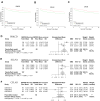Analyzing the molecular mechanism of Scutellaria Radix in the treatment of sepsis using RNA sequencing
- PMID: 38997656
- PMCID: PMC11241924
- DOI: 10.1186/s12879-024-09589-2
Analyzing the molecular mechanism of Scutellaria Radix in the treatment of sepsis using RNA sequencing
Abstract
Background: Sepsis is a life-threatening organ dysfunction, which seriously threatens human health. The clinical and experimental results have confirmed that Traditional Chinese medicine (TCM), such as Scutellariae Radix, has anti-inflammatory effects. This provides a new idea for the treatment of sepsis. This study systematically analyzed the mechanism of Scutellariae Radix treatment in sepsis based on network pharmacology, RNA sequencing and molecular docking.
Methods: Gene expression analysis was performed using Bulk RNA sequencing on sepsis patients and healthy volunteers. After quality control of the results, the differentially expressed genes (DEGs) were analyzed. The active ingredients and targets of Scutellariae Radix were identified using The Traditional Chinese Medicine Systems Pharmacology Database and Analysis Platform (TCMSP). Gene Ontology (GO) and Protein-Protein Interaction (PPI) analysis were performed for disease-drug intersection targets. With the help of GEO database, Survival analysis and Meta-analysis was performed on the cross-targets to evaluate the prognostic value and screen the core targets. Subsequently, single-cell RNA sequencing was used to determine where the core targets are located within the cell. Finally, in this study, molecular docking experiments were performed to further clarify the interrelationship between the active components of Scutellariae Radix and the corresponding targets.
Results: There were 72 active ingredients of Scutellariae Radix, and 50 common targets of drug and disease. GO and PPI analysis showed that the intersection targets were mainly involved in response to chemical stress, response to oxygen levels, response to drug, regulation of immune system process. Survival analysis showed that PRKCD, EGLN1 and CFLAR were positively correlated with sepsis prognosis. Meta-analysis found that the three genes were highly expressed in sepsis survivor, while lowly in non-survivor. PRKCD was mostly found in Macrophages, while EGLN1 and CFLAR were widely expressed in immune cells. The active ingredient Apigenin regulates CFLAR expression, Baicalein regulates EGLN1 expression, and Wogonin regulates PRKCD expression. Molecular docking studies confrmed that the three active components of astragalus have good binding activities with their corresponding targets.
Conclusions: Apigenin, Baicalein and Wogonin, important active components of Scutellaria Radix, produce anti-sepsis effects by regulating the expression of their targets CFLAR, EGLN1 and PRKCD.
Keywords: Molecular docking; Network pharmacology; RNA sequencing; Scutellariae Radix; Sepsis; Traditional Chinese medicine.
© 2024. The Author(s).
Conflict of interest statement
The authors declare no competing interests.
Figures







Similar articles
-
Exploring the potential mechanism of Radix Bupleuri in the treatment of sepsis: a study based on network pharmacology and molecular docking.BMC Complement Med Ther. 2024 Oct 1;24(1):347. doi: 10.1186/s12906-024-04637-5. BMC Complement Med Ther. 2024. PMID: 39354431 Free PMC article.
-
Identification of bioactive compounds and potential mechanisms of scutellariae radix-coptidis rhizoma in the treatment of atherosclerosis by integrating network pharmacology and experimental validation.Biomed Pharmacother. 2023 Sep;165:115210. doi: 10.1016/j.biopha.2023.115210. Epub 2023 Jul 25. Biomed Pharmacother. 2023. PMID: 37499457
-
Network-based pharmacology and molecular docking exploring the "Bupleuri Radix-Scutellariae Radix" mechanism of action in the viral hepatitis B treatment.Medicine (Baltimore). 2022 Dec 2;101(48):e31835. doi: 10.1097/MD.0000000000031835. Medicine (Baltimore). 2022. PMID: 36482557 Free PMC article.
-
Network pharmacology prediction and molecular docking-based strategy to explore the potential mechanism of Huanglian Jiedu Decoction against sepsis.Comput Biol Med. 2022 May;144:105389. doi: 10.1016/j.compbiomed.2022.105389. Epub 2022 Mar 9. Comput Biol Med. 2022. PMID: 35303581 Review.
-
[Progress of research on effect and mechanism of Scutellariae Radix on preventing liver diseases].Zhongguo Zhong Yao Za Zhi. 2020 Jun;45(12):2808-2816. doi: 10.19540/j.cnki.cjcmm.20200224.403. Zhongguo Zhong Yao Za Zhi. 2020. PMID: 32627454 Review. Chinese.
Cited by
-
Screening Therapeutic Core Genes in Sepsis Using Network Pharmacology and Single-Cell RNA Sequencing.Biochem Genet. 2025 Mar 20. doi: 10.1007/s10528-025-11075-6. Online ahead of print. Biochem Genet. 2025. PMID: 40113718
-
Forecasting the Pharmacological Mechanisms of Plumbago zeylanica and Solanum xanthocarpum in Diabetic Retinopathy Treatment: A Network Pharmacology, Molecular Docking, and Molecular Dynamics Simulation Study.Biology (Basel). 2024 Sep 18;13(9):732. doi: 10.3390/biology13090732. Biology (Basel). 2024. PMID: 39336159 Free PMC article.
References
-
- Singer M, Deutschman CS, Seymour CW, Shankar-Hari M, Annane D, Bauer M, Bellomo R, Bernard GR, Chiche JD, Coopersmith CM, et al. The Third International Consensus definitions for Sepsis and septic shock (Sepsis-3) Jama-journal Am Med Association. 2016;315(8):801–10. doi: 10.1001/jama.2016.0287. - DOI - PMC - PubMed
MeSH terms
Substances
LinkOut - more resources
Full Text Sources
Medical
Miscellaneous

